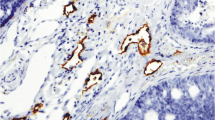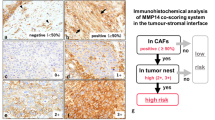Abstract
Recent research suggests that multinodular recurrent pleomorphic adenoma (PA) might result from cell migration through lymphatics. Lymphangiogenesis in malignancies is mediated by vascular endothelial growth factors C and D (VEGF-C/D). We studied the expression of VEGF-C/D in PA by immunohistochemistry as well as lymphatic vessel density (LVD). In 6 non-recurrent, 4 primary-to-recur, and 10 recurrent PAs, VEGF-C/D expression was assessed by immunohistochemistry. Staining was scored in terms of staining intensity (0 = absent to 3 = strong), and the percentage of positive tumor cells (scored as 0 (0–19 %), 1 (20–39 %), 2 (40–50 %), and 3 (60–100 %)) and a sum score were calculated. Intra- and peritumoral LVD was assessed by counting of LV after immunostaining, using the D2-40 antibody. All but one sample were VEGF-C negative. The differences in VEGF-D expression between non-recurrent, primary-to-recur, and recurrent PAs were not significant (p > 0.05). VEGF-D expression did not correlate with peritumoral LVD (p > 0.05). Our study revealed a significant difference between intra- and peritumoral LVD values when comparing individual and all sample groups (p = 0.01). The lack of VEGF-C expression and of significant differences in VEGF-D expression and peritumoral LVD between patients with non-recurrent, primary-to-recur, and recurrent PAs does not support the lymphangiogenic local spread hypothesis.




Similar content being viewed by others
References
Goudot P (1989) Pleomorphic adenoma of the salivary glands. Impact of the myxoid component on the prognosis. Rev Stomatol Chir Maxillofac 90:119–122
McGregor AD, Burgyone M, Tan KC (1988) Recurrent pleomorphic salivary adenoma—the relevance of age at first presentation. Br J Plast Surg 41:177–181
Zbären P, Stauffer E (2007) Pleomorphic adenoma of the parotid gland. Histopathologic analysis of the capsular characteristics of 218 cases. Head Neck 29:751–757
Stennert E et al (2004) Recurrent pleomorphic adenoma of the parotid gland: a prospective histopathological and immunohistochemical study. Laryngoscope 114:1538–1543
Brieger J (2008) Recurrence of pleomorphic adenoma of the parotid gland—predictive value of cadherin-11 and fascin. APMIS 116:1050–1057
Cao Y (2005) Opinion: emerging mechanism of tumour lymphangiogenesis and lymphatic metastasis. Nat Rev Cancer 5:735–743
Hazan RB, Qiao R, Keren R, Badano I, Suyama K (2004) Cadherin switch in tumor progression. Ann N Y Acad Sci 1014:155–163
Yamazaki Y, Morita T (2006) Molecular and functional diversity of vascular endothelial growth factors. Mol Divers 10(4):515–527
Matilla MMT, Ruohola JK, Karpanen T, Jackson DG, Alitalo K, Härkönen P (2002) VEGF-C induced lymphangiogenesis is associated with lymph node metastasis in orthotopic MCF-7 tumors. Int J Cancer 98:946–951
Nathanson SD (2003) Insights into the mechanism of lymph node metastasis. Cancer 98(2):413–423
Pepper MS, Tille JC, Nisato R et al (2003) Lymphangiogenesis and tumor metastasis. Cell Tissue Res 314:167–177
Skobe M, Hawighorst T, Jackson DG, Prevo R, Janes L, Velasco P, Riccardi L, Alitalo K, Claffey K, Detmar M (2001) Induction of tumor lymphangiogenesis by VEGF-C promotes breast cancer metastasis. Nat Med 2:192–198
Stacker SA, Achen MG, Jussila L et al (2002) Lymphangiogenesis and cancer metastasis. Nat Rev Cancer 2:573–583
Stacker SA, Caesar C, Baldwin ME et al (2001) VEGF-D promotes the metastatic spread of tumor cells via the lymphatics. Nat Med 7:186–191
Hu W-G, Li J-W, Feng B, Beveridge M, Yue F, Lu A-G, Ma J-J, Wang M-L, Guo Y, Jin X-L, Zheng M-H (2007) Vascular endothelial growth factors C and D represent novel prognostic markers in colorectal carcinoma using quantitative image analysis. Eur Surg Res 39(4):229–238
Choi WW, Lewis MM, Lawson D, Yi-Goen Q, Birdsong GG, Cotsonins GA, Cohen C, Young AN (2005) Angiogenic and lymphangiogenic microvessel density in breast carcinoma: correlation with clinicopathologic parameters and VEGF-family gene expression. Mod Pathol 18:143–152
Salven P, Lymboussaki A, Heikkila P, Jääskela-Saari H, Enholm B, Aase K, Euler G, Eriksson U, Alitalo K, Joensuu H (1998) Vascular endothelial growth factors VEGF-B and VEGF-C are expressed in human tumors. Am J Pathol 153(1):103–108
Tsurusaki T, Kanda S, Sakai H, Saito Y, Alitalo K, Koji T (1999) Vascular endothelial growth factor-C expression in human prostatic carcinoma and its relationship to lymph node metastasis. Br J Cancer 80:309–313
Kitadai Y, Amioka T, Haruma K, Tanaka S, Yoshihara M, Sumii K, Matsutani N, Yasui W, Chayama K (2001) Clinicopathological significance of vascular endothelial growth factor (VEGF)-C in human esophageal squamous cell carcinomas. Int J Cancer 93:662–666
O-charoenrat P, Rhys-Evans P, Eccles SA (2001) Expression of vascular endothelial growth factor family members in head and neck squamous cell carcinoma correlates with lymph node metastasis. Cancer 92(3):556–568
Baek SK, Jung KY, Lee SH, Woo JS, Kwon SY, Chung EJ, Kim TH, Chae YS (2009) Prognostic significance of vascular endothelial growth factor-C expression and lymphatic vessel density is supraglottic squamous cell carcinoma. Laryngoscope 119:1325–1330
Fujita G, Sato S, Kishino M, Iwai S, Nakazawa M, Toyosawa S, Yukra Y, Ogawa Y (2011) Lymphatic vessels and related factors in adenoid cystic carcinoma of the salivary gland. Mod Pathol 24(7):885–891
Mello MF, Costa AF, Freitas LL, Soares AB, Araujo VC, Tincani AJ, Martins AS, Altemani A (2011) Lymphatic vessel density and expressions of lymphangiogenic growth factors in salivary carcinomas. Neoplasma 58(4):331–336
Moriyama M, Kumagai S, Kawashiri S, Kojima K, Kakihara K, Yamamoto E (1997) Immunohistochemical study of tumour angiogenesis in oral squamous cell carcinoma. Oral Oncol 33(5):369–374
Lim JJ, Kang S, Lee MR, Pai HK, Yoon HJ, Lee JI, Hong SP, Lim CY (2003) Expression of vascular endothelial growth factor in salivary gland carcinomas and its relation to p53, Ki-67 and prognosis. J Oral Pathol Med 32(9):552–561
Liotta LA (1992) Cancer cell invasion and metastasis. Sci Am 266:34–41
Soares AB, Souza A, Santos F, Altemani A, Soares A, Araujo V (2011) The increased p16 expression in recurrence of salivary gland pleomorphic adenoma. Virchows Arch 459(Suppl 1):S118
Soares AB, Demasi AP, Altemani A, de Araujo VC (2011) Increased mucin 1 expression in recurrence and malignant transformation of salivary gland pleomorphic adenoma. Histopathology 58:377–382
Soares AB, Demasi AP, Tincani AJ, Martins AS, Altemani A, de Araújo VC (2012) The increased PDGF-A, PDGF-B and FGF-2 expression in recurrence of salivary gland pleomorphic adenoma. J Clin Pathol 65:272–277
Khademi B, Geramizadeh B, Gandorni B, Ghanbarian S (2003) Metastasizing pleomorphic adenoma of the tongue. Iran J Med Sci 28(3):143–145
Steele NP, Wenig BM, Sessions RB (2007) A case of pleomorphic adenoma of the parotid gland metastasizing to a mediastinal lymph node. Am J Otolaryngol 28(2):130–133
Padera TP, Kadambi A, Di Tomaso E, Carreira CM, Brown EB et al (2002) Lymphatic metastasis in the absence of functional intratumoral lymphatics. Science 296:1883–1886
Carmeliet P, Jain RK (2000) Angiogenesis in cancer and other diseases. Nature 407:249–257
Leu AJ, Berk DA, Lymboussaki A, Alitalo K, Jain RK (2000) Absence of functional lymphatics within a murine sarcoma: a molecular and functional evaluation. Cancer Res 60:4324–4327
Tanigawa N et al (1981) Experimental study on lymphatic vascular changes in the development of cancer. Lymphology 14:149–154
Audet N, Beasly NJ, MacMillan C, Jackson DG, Gullane PJ et al (2005) Lymphatic vessel density, nodal metastasis, and prognosis in patients with head and neck cancer. Arch Otolaryngol Head Neck Surg 131:1065–1070
Beasly NJ, Prevo R, Banerji S, Leek RD, Moore et al (2002) Intratumoral lymphangiogenesis and lymph node metastasis in head and neck cancer. Cancer Res 62:1315–1320
Dadras SS, Paul T, Bertoncini J, Brown LF, Muzikansky A, Jackson DG, Ellwanger U, Garbe C, Mihm M, Detmar M (2003) Tumor lymphangiogenesis: a novel prognostic indicator for cutaneous melanoma metastasis and survival. Am J Pathol 162(6):1951–1960
Kyzas PA, Geleff S, Batistatou A et al (2005) Evidence for lymphangiogenesis and its prognostic implications in head and neck squamous cell carcinoma. J Pathol 206:170–177
Schmid K, Birner P, Gravenhorst V et al (2005) Prognostic value of lymphatic and blood vessel invasion in neuroendocrine tumors of the lung. Am J Surg Pathol 29:324–328
Schoppmann SF, Horvath R, Birner P (2002) Lymphatic vessels and lymphangiogenesis in female cancer: mechanism, clinical impact and possible implications for anti-lymphangiogenic therapies (Review). Oncol Rep 9:455–460
Williams CSM, Leek RD, Robson AM et al (2003) Absence of lymphangiogenesis and intratumoral lymph vessels in human metastatic breast cancer. J Pathol 200:195–206
Teymoortash A, Schrader C, Shimoda H, Kato S, Werner JA (2007) Evidence of lymphangiogenesis in Warthin's tumor of the parotid gland. Oral Oncol 43:614–618
Soares AB, De Araujo VC, Juliano PB, Altemani A (2009) Angiogenic and lymphangiogenic microvessel density in recurrent pleomorphic adenoma. J Oral Pathol Med 38(8):623–629
Swelam W, Ida-Yonemochi H, Maruyama S, Ohshiro K, Cheng J, Saku T (2005) Vascular endothelial growth factor in salivary pleomorphic adenomas: one of the reasons for their poorly vascularized stroma. Virchows Arch 446(6):653–662
Soares AB, Juliano PB, Araújo VC, Altemani A (2007) Lymphatic vascular density and lymphangiogenesis during tumor progression of carcinoma ex pleomorphic adenoma. J Clin Pathol 60(9):995–1000
Currie MJ, Hanrahan V, Gunningham SP, Morrin HR, Frampton C, Han C, Robinson BA, Fox SB (2004) Expression of vascular endothelial growth factor D is associated with hypoxia inducible factor (HIF-1 alpha) and the HIF-1 alfa target gene DEC1, but not lymph node metastasis in primary human breast carcinoma. J Clin Pathol 57(8):829–834
Tzao C, Lee SC, Tung HJ, Hsu HS, Hsu WH, Sun GH, Yu CP, Jin JS, Cheng YL (2008) Expression of hypoxia induced factor (HIF)-1alpha and vascular endothelial growth factor (VEGF)-D as outcome predictors in resected esophageal squamous cell carcinoma. Dis Markers 25(3):141–148
Harris NC, Paavonen K, Davydova N, Roufail S, Sato T, Zhang YF, Karnezis T, Stacker SA, Achen MG (2011) Proteolytic processing of vascular endothelial growth factor-D is essential for its capacity to promote the growth and spread of cancer. FASEB J 25(8):2615–2625
Acknowledgments
This study was supported by the Institutional Support of the Ministry of Health, Czech Republic, Nr. 1RVO-FNOL.2013, and IGA Czech Republic, Nr. NT13701-4/2012. Mr. George Kumsta is acknowledged for his help with the final English revision.
Conflict of interest
The authors declare that they have no conflicts of interest.
Author information
Authors and Affiliations
Corresponding author
Rights and permissions
About this article
Cite this article
Salzman, R., Stárek, I., Kučerová, L. et al. Neither expression of VEGF-C/D nor lymph vessel density supports lymphatic invasion as the mechanism responsible for local spread of recurrent salivary pleomorphic adenoma. Virchows Arch 464, 29–34 (2014). https://doi.org/10.1007/s00428-013-1502-5
Received:
Accepted:
Published:
Issue Date:
DOI: https://doi.org/10.1007/s00428-013-1502-5




